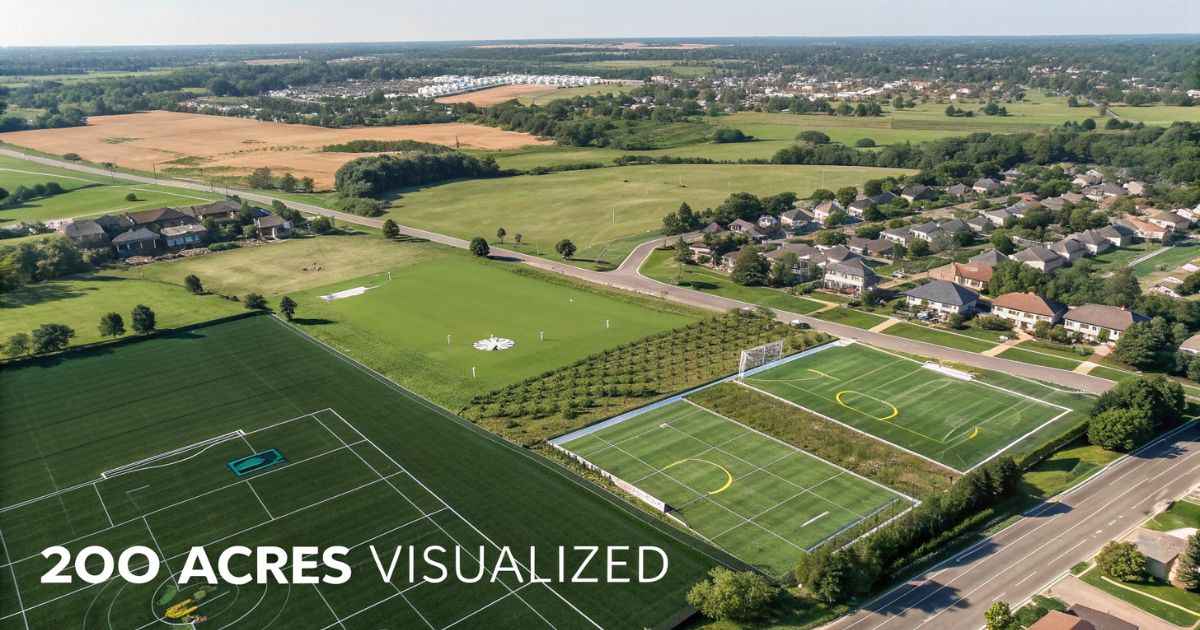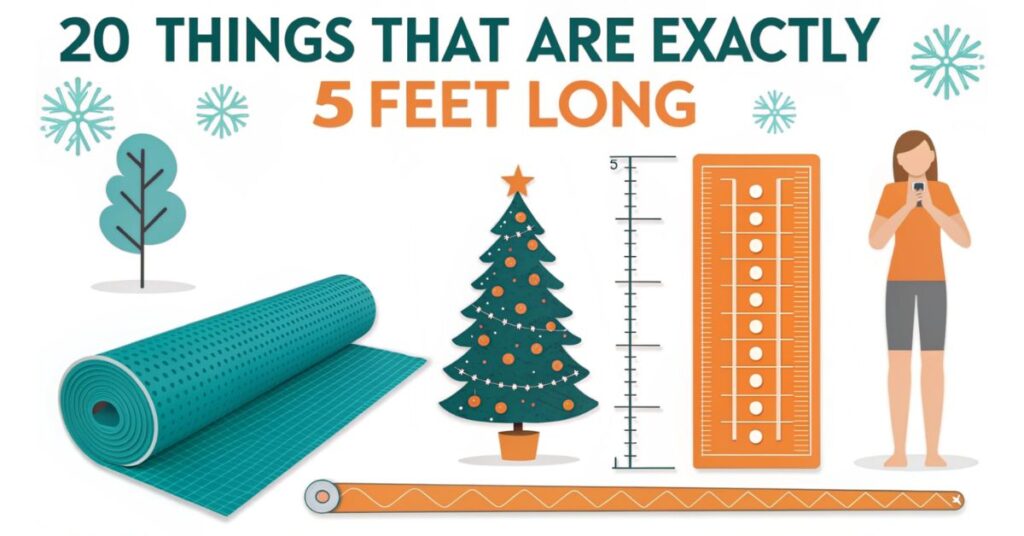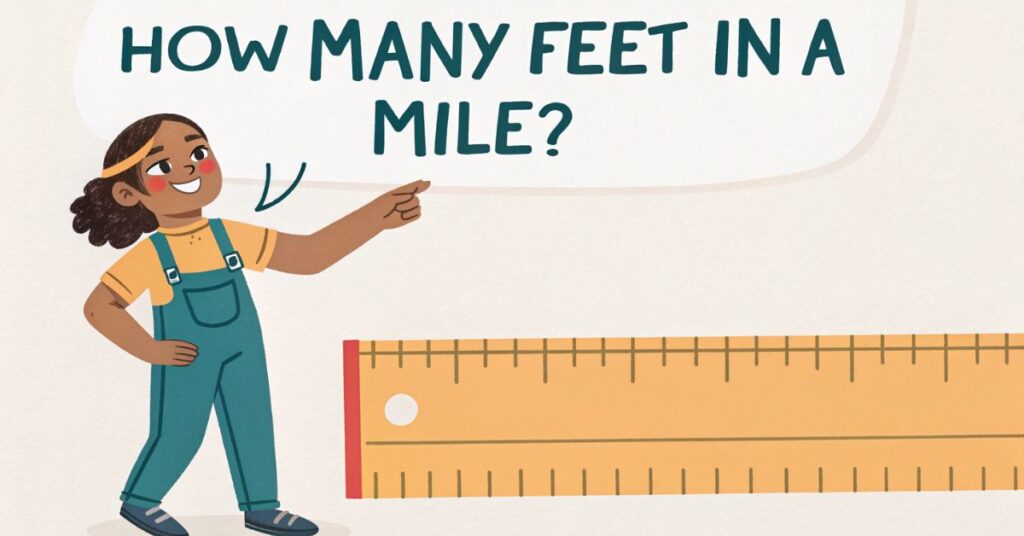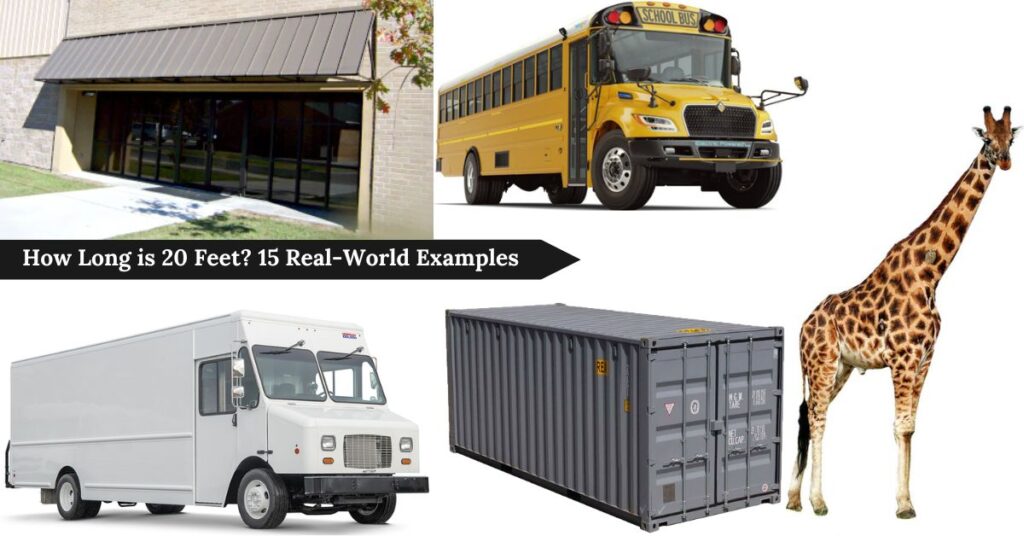You’ve probably heard someone mention 200 acres and nodded along, pretending you could visualize it.
Most of us can’t accurately picture land measurements beyond our own yards, yet understanding acreage matters when buying property, reading news about wildfires, or simply grasping the scale of farmland.
What Exactly Is an Acre?
Before we dive into 200 acres, you need to grasp what a single acre actually represents.
📏 The Precise Measurement
1 Acre = 43,560 Square Feet
That’s equivalent to a square plot about 208.7 feet on each side!
🌾 A Bit of History
This isn’t a random number—it’s rooted in medieval England!
Farmers measured land by how much a team of oxen could plow in one day.
🖼️ Visual Size Comparisons
To help you picture it better, here’s how one acre stacks up against everyday things:
American Football Field
(Minus end zones)
≈ 1.1 acres
So, 1 acre is about 90% of this.
Tennis Court
≈ 0.023 acres
You’d need about 43 to make an acre!
Basketball Court
≈ 0.06 acres
About 16-17 courts per acre.
These visuals make it easier to imagine without the confusion—now you’re ready for 200 acres! 🌍
Before we dive into 200 acres, you need to grasp what a single acre actually represents.
An acre equals precisely 43,560 square feet. That’s not a random number—it originates from medieval England, where farmers measured land by how much a team of oxen could plow in one day.
The Raw Numbers :200 Acres
Let’s translate 200 acres into figures that actually mean something.
Square footage: 8,712,000 square feet. That number looks massive because it is—imagine writing that on a property deed.
Square miles: Approximately 0.3125 square miles. You’re covering nearly a third of a square mile, which suddenly sounds more manageable.
If you shaped those 200 acres into a perfect square, each side would stretch 2,937 feet—that’s over half a mile (0.56 miles, to be exact). Walking straight across would take you 10-12 minutes at a normal pace.
Want to walk the entire perimeter? You’re looking at roughly 2.4 miles of walking, which takes most people 45-60 minutes depending on terrain. Bring comfortable shoes.
Comparison #1: Football Fields (The Gold Standard)
Here’s the comparison every American instinctively understands: football fields.
📊 The Jaw-Dropping Math
200 acres equals approximately 151 football fields (including those end zones).
Yes, 151. Not 15. Not 51. One hundred fifty-one full-sized gridirons.
Regulation NFL Field: 360 ft long × 160 ft wide = 57,600 sq ft = 1.32 acres
200 ÷ 1.32 = 151.5 fields
🏟️ Picture This: Your Local Stadium × 151
Think about your local high school or college stadium. Now multiply it by 151. That’s the raw footprint we’re discussing.
1 Football Field
= 1.32 acres
×
151
200 Acres
= Massive Land!
No more guessing—151 fields is a sea of green that stretches farther than the eye can see! Ready for the next comparison? 🚀
Here’s the comparison every American instinctively understands: football fields.
200 acres equals approximately 151 football fields (including those end zones). Yes, 151. Not 15. Not 51. One hundred fifty-one full-sized gridirons.
Think about your local high school or college stadium. Now multiply it by 151. That’s the raw footprint we’re discussing.
A regulation NFL field measures 360 feet long (including end zones) by 160 feet wide, totaling 57,600 square feet or 1.32 acres. Do the math: 200 ÷ 1.32 = 151.5 fields.
Comparison #2: City Blocks (Urban Perspective)
If you’re an urbanite who’s never stepped foot on farmland, let’s translate 200 acres into city blocks.
📊 Urban Math Made Simple
Using a national average of approximately 1.8 acres per city block,
200 acres = 111 city blocks
National Average Block: 1.8 acres
200 ÷ 1.8 = 111 blocks
🌆 City Block Sizes Vary Wildly
Across America, blocks aren’t one-size-fits-all. Here’s how 200 acres stacks up in key cities:
Manhattan
≈ 2 acres/block
200 acres = 100 blocks
Chicago
≈ 1.7 acres/block
200 acres = 118 blocks
Portland
≈ 1.4 acres/block
200 acres = 143 blocks
Whether it’s the hustle of NYC or the breeze of Portland, 200 acres covers a neighborhood’s worth of blocks—no farmland required! Next up? 🚀
If you’re an urbanite who’s never stepped foot on farmland, let’s translate 200 acres into city blocks.
City block sizes vary wildly across America. A standard Manhattan block covers about 2 acres. Chicago’s blocks? Roughly 1.7 acres. Portland’s compact blocks measure closer to 1.4 acres.
Using a national average of approximately 1.8 acres per city block, 200 acres equals about 111 city blocks.
Comparison #3: Central Park Segments
New York’s Central Park spans 843 acres, making it one of America’s most recognized land parcels.
📊 A Quarter of the Icon
200 acres represents nearly 24% of Central Park
—almost a quarter of that iconic green space!
200 ÷ 843 ≈ 0.24 (or 24%)
🌳 Key Spots in Central Park
To visualize this more precisely, here’s how famous features add up:
Great Lawn
55 acres
Sheep Meadow
15 acres
Reservoir
106 acres
Reservoir + Great Lawn = 161 acres
Approaching your 200 acres!
🚶♂️ A Walk in the Park
If you’ve ever walked Central Park from south to north (2.5 miles),
imagine covering just the first quarter of that journey.
That’s your 200-acre footprint—right at the start!
From skyline picnics to scenic strolls, 200 acres captures the essence of Central Park’s magic—without leaving the city! What’s next? 🚀
New York’s Central Park spans 843 acres, making it one of America’s most recognized land parcels.
200 acres represents nearly 24% of Central Park—almost a quarter of that iconic green space.
To visualize this more precisely: The Great Lawn in Central Park covers 55 acres. Sheep Meadow adds another 15 acres. The Reservoir? That’s 106 acres. Combine the Reservoir with the Great Lawn, and you’re approaching 200 acres.
If you’ve ever walked Central Park from south to north (2.5 miles), imagine covering just the first quarter of that journey. That’s your 200-acre footprint.
Comparison #4: Walmart Supercenters
The average Walmart Supercenter occupies about 187,000 square feet (roughly 4.3 acres), including the building and parking lot.
📊 Retail Math
200 acres equals approximately 46-47 Walmart Supercenters sitting side by side.
Average Walmart: 187,000 sq ft = 4.3 acres
200 ÷ 4.3 ≈ 46.5 stores
🛒 Clone Your Local Walmart × 46
Imagine your local Walmart. Now clone it 46 times and arrange them in a grid. That’s the sheer commercial footprint of 200 acres.
1 Walmart
4.3 acres
×
46
…and 40 more!
= 200 Acres Grid
A mega-mall of Walmarts—enough shopping carts to circle the block! What’s the next scale-up? 🚀
The average Walmart Supercenter occupies about 187,000 square feet (roughly 4.3 acres), including the building and parking lot.
200 acres equals approximately 46-47 Walmart Supercenters sitting side by side.
Imagine your local Walmart. Now clone it 46 times and arrange them in a grid. That’s the sheer commercial footprint of 200 acres.
Comparison #5: Baseball Diamonds
A standard baseball field (with outfield) covers 2-3 acres depending on whether we’re talking Little League or MLB dimensions.
📊 Swing for the Fences Math
Using the average of 2.5 acres per field,
200 acres accommodates roughly 80 baseball diamonds
Average Field: 2.5 acres
200 ÷ 2.5 = 80 fields
⚾ Field Size Breakdown
From pint-sized youth diamonds to pro-level outfields, here’s how 200 acres stacks up:
Youth Fields
~2 acres each
200 acres = 100 fields
MLB Fields
~3 acres each
200 acres = 67 fields
🏟️ Fenway Park Special
Fenway Park, including seating and concourses, occupies about 9 acres total.
So you could fit 22 Fenway Parks (field areas only) into 200 acres.
Fenway Total: 9 acres
200 ÷ 9 ≈ 22 parks
🌐 A Sea of Diamonds
Picture an endless Little League tournament: 100 fields buzzing with kids, or a pro league with 67 grand slams waiting.
1 Field
2.5 acres
×
80
…and 71 more!
= 200 Acres of Glory
Home runs over horizons—200 acres is a ballpark bonanza! Batter up for the next comparison? 🚀
A standard baseball field (with outfield) covers 2-3 acres depending on whether we’re talking Little League or MLB dimensions.
Using the average of 2.5 acres per field, 200 acres accommodates roughly 80 baseball diamonds.
Fenway Park, including seating and concourses, occupies about 9 acres total. So you could fit 22 Fenway Parks (field areas only) into 200 acres.
Youth fields run smaller—about 2 acres—meaning you’d squeeze in 100 of those. MLB fields with their expansive outfields push toward 3 acres each, dropping the count to 67 fields.
Comparison #6: Soccer Fields
A regulation soccer field measures 1.32-1.76 acres, depending on whether it’s built to FIFA international standards or local youth league dimensions.
📊 Goal-Getter Math
Using 1.5 acres as our average,
200 acres holds approximately 133 soccer fields
Average Field: 1.5 acres
200 ÷ 1.5 ≈ 133 fields
⚽ Size Variations
The variation matters. Here’s the breakdown:
International (FIFA)
1.76 acres each
200 acres = 114 fields
Youth Fields
1.32 acres each
200 acres = 152 fields
🏫 Schoolyard Scale
For context: A typical high school has 1-2 soccer fields.
You’re envisioning 65-130 high schools’ worth of soccer infrastructure in one 200-acre parcel.
High School: 1-2 fields (1.32-3.52 acres total)
200 acres ≈ 65-130 schools
🌐 Endless Pitch Party
An international field (110-120 yards long, 70-80 yards wide) maximizes that 1.76-acre footprint. Youth fields shrink to 1.32 acres, letting you pack more into the same space.
1 Field
1.5 acres
×
133
…and 124 more!
= 200 Acres of Goals
From World Cup dreams to schoolyard scrambles, 200 acres is a soccer stadium symphony! Lace up for the next one? 🚀
A regulation soccer field measures 1.32-1.76 acres, depending on whether it’s built to FIFA international standards or local youth league dimensions.
Using 1.5 acres as our average, 200 acres holds approximately 133 soccer fields.
The variation matters. An international field (110-120 yards long, 70-80 yards wide) maximizes that 1.76-acre footprint. Youth fields shrink to 1.32 acres, letting you pack more into the same space.
For context: A typical high school has 1-2 soccer fields. You’re envisioning 65-130 high schools’ worth of soccer infrastructure in one 200-acre parcel.
Sports complex developers live and breathe these calculations. That “regional soccer complex” proposed in your county? It’s probably targeting 50-100 acres to fit tournament-grade facilities.
Comparison #7: The National Mall in Washington D.C.
Washington D.C.’s National Mall stretches 309 acres from the Capitol Building to the Lincoln Memorial.
📊 A Monumental Slice
200 acres equals approximately 65% of the National Mall.
200 ÷ 309 ≈ 0.65 (or 65%)
🗽 Iconic Landmarks Along the Way
The Mall’s 1.9-mile stretch is dotted with history—here’s the layout:
Capitol Building
Start Point
0 miles
Washington Monument
Midway
~1 mile from start
Lincoln Memorial
End Point
1.9 miles total
🚶♂️ Your Patriotic Stroll
Imagine standing at the Capitol steps. Walk toward the Washington Monument. Keep going past the Monument toward the Lincoln Memorial.
Stop about two-thirds of the way there.
That distance and width? That’s your 200-acre footprint!
From reflecting pools to reflective thoughts, 200 acres marches like a rally on the Mall! Onward to the next? 🚀
Washington D.C.’s National Mall stretches 309 acres from the Capitol Building to the Lincoln Memorial.
200 acres equals approximately 65% of the National Mall.
Imagine standing at the Capitol steps. Walk toward the Washington Monument. Keep going past the Monument toward the Lincoln Memorial. Stop about two-thirds of the way there. That distance and width? That’s your 200 acres.
The Mall hosts over 25 million visitors annually. Those crowds disperse across 309 acres, yet it still feels packed during major events. Shrink that to 200 acres during the Fourth of July, and you’d understand density viscerally.
Comparison #8: Disney Theme Parks
Disney’s Magic Kingdom in Florida covers 107 acres of actual theme park (not counting parking, hotels, or backstage areas).
📊 Magic Kingdom Math
200 acres equals nearly 2 Magic Kingdoms placed side by side.
Magic Kingdom: 107 acres
200 ÷ 107 ≈ 1.87 parks
🎢 Original Disneyland
California’s original Disneyland is more compact at 85 acres,
meaning 200 acres fits 2.35 Disneylands.
Disneyland: 85 acres
200 ÷ 85 ≈ 2.35 parks
🛤️ Side-by-Side Magic
Picture two full Magic Kingdoms bumper-to-bumper—enough castles for double the fairy tales!
1 Magic Kingdom
107 acres
+
1 More!
= 214 acres
🚶♂️ The Enchanted Trek
Think about how long it takes to walk from the entrance of Magic Kingdom to the back of Fantasyland—20-25 minutes of steady walking through crowds.
You’d need to do that trek twice to cover 200 acres.
Double the dreams, double the distance—200 acres is a happily ever after times two! What’s the grand finale? 🚀
Disney’s Magic Kingdom in Florida covers 107 acres of actual theme park (not counting parking, hotels, or backstage areas).
200 acres equals nearly 2 Magic Kingdoms placed side by side.
California’s original Disneyland is more compact at 85 acres, meaning 200 acres fits 2.35 Disneylands.
Think about how long it takes to walk from the entrance of Magic Kingdom to the back of Fantasyland—20-25 minutes of steady walking through crowds. You’d need to do that trek twice to cover 200 acres.
Disney’s entire Walt Disney World Resort sprawls across 25,000 acres (we’ll address that properly later). But the actual parks where guests spend time? Much smaller. Your 200 acres would create a respectable mid-sized theme park with room for hotels.
Comparison #9: Golf Courses
Golf courses provide an excellent acreage benchmark because they’re specifically designed around land use.
📊 Fairway Math
An average 18-hole championship golf course requires 140-160 acres, including fairways, greens, roughs, water features, and cart paths.
200 acres comfortably fits 1 full championship course
with room left for a clubhouse, practice facilities, parking lots, and maintenance buildings!
Average Course: 150 acres
200 ÷ 150 ≈ 1.33 courses
🏌️♂️ Range Breakdown
Depending on the design, here’s how 200 acres plays out:
Compact (140 acres)
200 acres = 1.43 courses
Average (150 acres)
200 acres = 1.33 courses
Expansive (160 acres)
200 acres = 1.25 courses
🌿 Your Private Par-3 Paradise
One full 18-hole championship course, plus extras—tee off into luxury!
1 Course
150 acres
+
50 acres extras
= 200 Acres of Greens
(Clubhouse + Practice + Parking)
Fore-ever green: 200 acres is your hole-in-one homestead! Tee off to the finale? 🚀
Golf courses provide an excellent acreage benchmark because they’re specifically designed around land use.
An average 18-hole championship golf course requires 140-160 acres, including fairways, greens, roughs, water features, and cart paths.
200 acres comfortably fits one full championship golf course with room left for a clubhouse, practice facilities, parking lots, and maintenance buildings.
Prestigious courses like Augusta National occupy about 365 acres, but they’re outliers with extra real estate for buffers and aesthetics. Most municipal courses hover around 150 acres.
Nine-hole courses shrink to 50-70 acres. You could theoretically fit 2.5 to 3 nine-hole courses into 200 acres, though that would feel cramped.
Golf course developers eye 200-acre parcels eagerly—it’s the sweet spot for creating a quality course without excess land driving up costs.
Comparison #10: Aircraft Carriers
The USS Gerald R. Ford, America’s newest aircraft carrier, has a flight deck covering approximately 4.5 acres.
📊 Naval Scale Math
200 acres equals 44 aircraft carrier decks lined up edge to edge.
Yes, 44 floating cities, each carrying 75+ aircraft and 4,500+ crew members.
Flight Deck: 4.5 acres
200 ÷ 4.5 ≈ 44.4 decks
✈️ A Fleet of Epic Proportions
The sheer ridiculousness of this comparison actually helps your brain process the magnitude—imagine a horizon of steel behemoths!
1 Carrier Deck
4.5 acres
×
44
…and 36 more!
= 200 Acres Armada
A navy of nightmares (or dreams)—200 acres sails supreme! What’s the wrap-up? 🚀
The USS Gerald R. Ford, America’s newest aircraft carrier, has a flight deck covering approximately 4.5 acres.
200 acres equals 44 aircraft carrier decks lined up edge to edge.
Yes, 44 floating cities, each carrying 75+ aircraft and 4,500+ crew members. The sheer ridiculousness of this comparison actually helps your brain process the magnitude.
An aircraft carrier feels enormous when you stand on its deck. The realization that you’d need 44 of them to match 200 acres drives home just how substantial that land parcel truly is.
Comparison #11: Residential Lots
A typical suburban lot ranges from 0.25 to 0.33 acres (roughly 10,890-14,375 square feet). Those quarter-acre lots define suburban America’s landscape.
📊 Suburban Sprawl Math
200 acres accommodates 600-800 single-family homes with standard yards.
Larger Lots (0.33 acres): 200 ÷ 0.33 ≈ 606 homes
Smaller Lots (0.25 acres): 200 ÷ 0.25 = 800 homes
🏘️ Your Neighborhood × 100
Picture your neighborhood. Count the houses on your block. Now multiply that by however many blocks it takes to reach 600-800 homes. You’re envisioning an entire subdivision, complete with winding streets, cul-de-sacs, and probably a retention pond.
Your Block
~10-15 homes
×
50-80
blocks
= 600-800 Homes
Full Subdivision
🏗️ Developer Dream
Developers salivate over 200-acre parcels near growing cities because they represent complete neighborhood opportunities.
Add infrastructure, and you’ve created a small community from scratch—schools, parks, and all!
From white picket fences to community barbecues, 200 acres builds the American Dream—block by block! Finale awaits? 🚀
A typical suburban lot ranges from 0.25 to 0.33 acres (roughly 10,890-14,375 square feet). Those quarter-acre lots define suburban America’s landscape.
200 acres accommodates 600-800 single-family homes with standard yards.
Picture your neighborhood. Count the houses on your block. Now multiply that by however many blocks it takes to reach 600-800 homes. You’re envisioning an entire subdivision, complete with winding streets, cul-de-sacs, and probably a retention pond.
Developers salivate over 200-acre parcels near growing cities because they represent complete neighborhood opportunities. Add infrastructure, and you’ve created a small community from scratch.
In denser configurations (0.15-acre lots), you’d squeeze 1,300+ homes into 200 acres. Urban planners constantly debate these density trade-offs.
Comparison #12: Farms and Agricultural Context
A small family farm typically ranges from 50-200 acres. You’re sitting at the upper threshold of what one family can manage without significant hired help.
🌽 Crop Yields: Harvest Heaven
Depending on soil, weather, and management, here’s what 200 acres could produce:
Corn
35,000-40,000 bushels
per harvest
Soybeans
9,000-10,000 bushels
annually
Wheat
8,000-12,000 bushels
per season
Hay
400-600 tons
for livestock feed
🐄 Livestock: Pasture Power
For grazing operations, 200 acres supports:
Cattle
100-200 head
with rotational grazing
Sheep
400-800 sheep
depending on pasture quality
Horses
50+ horses
premier equestrian facility
📋 USDA Farm Size Snapshot
The USDA defines a “small farm” as anything under 179 acres,
making 200 acres the entry point to “mid-sized” farming operations.
This acreage provides endless possibilities—from grains to grazing!
From seeds to herds, 200 acres is a canvas for your farming legacy—no confusion, just pure potential! 🌟
A small family farm typically ranges from 50-200 acres. You’re sitting at the upper threshold of what one family can manage without significant hired help.
What could you grow on 200 acres?
- Corn: Approximately 35,000-40,000 bushels per harvest (depending on soil quality and weather)
- Soybeans: Around 9,000-10,000 bushels annually
- Wheat: 8,000-12,000 bushels per season
- Hay: 400-600 tons of hay for livestock feed
For livestock operations:
- Cattle: 100-200 head of cattle with rotational grazing
- Sheep: 400-800 sheep depending on pasture quality
- Horses: A premier equestrian facility with 50+ horses, training facilities, and trails
The USDA defines a “small farm” as anything under 179 acres, making 200 acres the entry point to “mid-sized” farming operations. This acreage provides enough diversity to hedge against crop failures while remaining manageable.
Comparison #13: Parking Spaces
A standard parking space measures 9 feet wide by 20 feet long (180 square feet), including approach lanes and circulation space.
📊 Endless Asphalt Math
200 acres equals approximately 48,400 parking spaces.
200 acres = 8,712,000 sq ft (43,560 × 200)
8,712,000 ÷ 180 = 48,400 spaces
🛍️ Mall of America Madness
That’s every parking spot at several regional malls combined. The Mall of America, one of the largest retail complexes in the U.S., has about 20,000 parking spaces across its lots.
You’d need 2.4 Mall of America parking areas to hit 200 acres.
Mall of America: 20,000 spaces
48,400 ÷ 20,000 ≈ 2.4 lots
✈️ Airport Lot Labyrinth
Airport parking? A typical airport long-term lot covers 20-40 acres.
You’re envisioning 5-10 of those sprawling lots that seem to stretch forever when you’re dragging luggage.
Typical Lot: 20-40 acres
200 ÷ 40 = 5 lots | 200 ÷ 20 = 10 lots
🚗 A Sea of Shiny Cars
Imagine rows upon rows of parked vehicles—endless blacktop under the sun!
1 Space
180 sq ft
×
48,400
…and 48,396 more!
= 200 Acres of Asphalt
From mall marathons to airport treks, 200 acres is a parker’s paradise (or nightmare)! Ready for the harvest? 🚀
A standard parking space measures 9 feet wide by 20 feet long (180 square feet), including approach lanes and circulation space.
200 acres equals approximately 48,400 parking spaces.
That’s every parking spot at several regional malls combined. The Mall of America, one of the largest retail complexes in the U.S., has about 20,000 parking spaces across its lots. You’d need 2.4 Mall of America parking areas to hit 200 acres.
Airport parking? A typical airport long-term lot covers 20-40 acres. You’re envisioning 5-10 of those sprawling lots that seem to stretch forever when you’re dragging luggage.
Comparison #14: Tennis Courts
A regulation tennis court with surrounding space (run-off areas, fencing) requires about 0.20 acres (approximately 7,200 square feet for the court plus 1,400 square feet of buffer).
📊 Ace Math
200 acres equals roughly 1,000 tennis courts.
Court + Buffer: 0.20 acres
200 ÷ 0.20 = 1,000 courts
🥇 Wimbledon Grandeur
The entire Wimbledon complex in London occupies about 42 acres, containing 19 tournament courts and practice facilities.
You could fit nearly 5 Wimbledon-sized complexes into 200 acres.
Wimbledon: 42 acres
200 ÷ 42 ≈ 4.76 complexes
🏘️ Community Court Craze
For community planning: A typical city tennis center has 8-12 courts on 2-3 acres.
Your 200 acres creates 65-80 such facilities—enough to serve a metro area of several million people.
City Center: 2-3 acres
200 ÷ 3 ≈ 67 | 200 ÷ 2.5 ≈ 80 centers
🎾 A Grand Slam Grid
From Wimbledon whites to neighborhood nets, 200 acres serves up endless volleys!
1 Court
0.20 acres
×
1,000
…and 996 more!
= 200 Acres of Aces
Love all? More like love 1,000—200 acres is a tennis tournament triumph! Game, set, match to the next? 🚀
A regulation tennis court with surrounding space (run-off areas, fencing) requires about 0.20 acres (approximately 7,200 square feet for the court plus 1,400 square feet of buffer).
200 acres equals roughly 1,000 tennis courts.
The entire Wimbledon complex in London occupies about 42 acres, containing 19 tournament courts and practice facilities. You could fit nearly 5 Wimbledon-sized complexes into 200 acres.
For community planning: A typical city tennis center has 8-12 courts on 2-3 acres. Your 200 acres creates 65-80 such facilities—enough to serve a metro area of several million people.
Comparison #15: The LA Wildfires (Timely Context)
Recent California wildfires have burned hundreds of thousands of acres, with individual fires ranging from 500 acres (a “small” fire by modern standards) to 250,000+ acres for catastrophic events.
📊 Fire Scale Snapshot
200 acres represents a modest wildfire
—the size that might make local news but wouldn’t typically trigger mass evacuations.
Small Fire: 500 acres (Local Alert)
Catastrophic: 250,000+ acres (State Emergency)
200 acres = Modest Blaze
🏘️ Urban-Wildland Danger Zone
However, in urban-wildland interface zones, 200 acres of burning could consume hundreds of homes if winds spread embers.
Modest Fire
200 acres
Local News
Urban Interface
Ember Spread
Hundreds of Homes at Risk
🌪️ 2017 Tubbs Fire Case Study
The 2017 Tubbs Fire in Napa burned 36,807 acres and destroyed 5,643 structures.
Proportionally, 200 acres in that scenario could threaten 30+ homes.
Tubbs Fire: 36,807 acres = 5,643 structures destroyed
(5,643 ÷ 36,807) × 200 ≈ 31 homes
A spark that starts small but packs a punch—200 acres reminds us fire’s fury knows no bounds! Ember alert for the next? 🚀
Recent California wildfires have burned hundreds of thousands of acres, with individual fires ranging from 500 acres (a “small” fire by modern standards) to 250,000+ acres for catastrophic events.
200 acres represents a modest wildfire—the size that might make local news but wouldn’t typically trigger mass evacuations.
However, in urban-wildland interface zones, 200 acres of burning could consume hundreds of homes if winds spread embers. The 2017 Tubbs Fire in Napa burned 36,807 acres and destroyed 5,643 structures. Proportionally, 200 acres in that scenario could threaten 30+ homes.
How 200 Acres Compares to Other Common Land Sizes
200 Acres vs. 5 Acres
5 acres represents a large residential estate or hobby farm—enough space for a substantial home, outbuildings, a pond, and maybe a few horses.
200 acres is 40 times larger than 5 acres. That’s the jump from a private estate to a working ranch or commercial development.
200 Acres vs. 10 Acres
10 acres often represents a small farm, vineyard, or development parcel—enough to do something meaningful but still manageable for a small team.
200 acres is 20 times that footprint, crossing into territory where you need equipment, employees, and serious capital investment.
200 Acres vs. 40 Acres
The phrase “40 acres and a mule” carries profound historical weight in American history.
After the Civil War, Union General William T. Sherman’s Special Field Order No. 15 promised freed slaves 40-acre plots and a mule to work the land. The federal government later reneged on most of these promises, preventing generational wealth-building for millions of Black families.
200 acres equals 5 times that broken promise—the difference between subsistence farming and genuine agricultural prosperity.
FAQ’s
How many acres in a square mile?
640 acres equal exactly 1 square mile. This is a legal definition in U.S. land surveying, part of the Public Land Survey System established in 1785.
Since 200 acres equals 0.3125 square miles, you’d need 3.2 parcels of 200 acres to make a full square mile.
The math: 1 square mile = 5,280 feet × 5,280 feet = 27,878,400 square feet. Divide by 43,560 square feet per acre = 640 acres.
How many acres is a football field?
A regulation NFL football field is 1.32 acres including end zones (360 feet long × 160 feet wide = 57,600 square feet).
The playing field alone (without end zones) measures 1.1 acres (300 feet × 160 feet = 48,000 square feet).
What does “40 acres and a mule” mean?
“40 acres and a mule” refers to Special Field Order No. 15, issued by Union General William T. Sherman in January 1865.
The order redistributed roughly 400,000 acres of Confederate coastal land in South Carolina, Georgia, and Florida to newly freed Black families. Each family received up to 40 acres and sometimes a surplus Army mule.
How many acres in a mile?
This question confuses people because it conflates linear miles with square miles.
A linear mile (5,280 feet) doesn’t have acreage—it’s a one-dimensional measurement. If you create a strip 1 mile long and 1 foot wide, that’s only 0.12 acres.
A square mile contains 640 acres (as covered above).
How many acres have burned in LA?
California wildfire acreage varies annually. In 2024, California experienced approximately 1.2 million acres burned across all fires.
The Palisades Fire (January 2025) burned over 23,000 acres in Los Angeles County, destroying more than 5,000 structures.
How many acres is Disney World?
Walt Disney World Resort in Florida occupies approximately 25,000 acres (39 square miles)—making it roughly the size of San Francisco.
How many acres in a hectare?
One hectare equals 2.471 acres. Conversely, one acre equals 0.4047 hectares.
200 acres converts to 80.94 hectares.
The hectare is the international standard (part of the metric system), used by every country except the United States, Myanmar, and Liberia for land measurement.
How many acres is Central Park?
Central Park spans 843 acres (1.317 square miles), making it the fifth-largest park in New York City despite being its most famous.
The park measures 2.5 miles long (north to south) and 0.5 miles wide (east to west). Approximately 150 million visitors explore it annually.
How big is 5 acres?
5 acres equals 217,800 square feet—about 3.75 football fields.
If squared, each side measures 466.7 feet (slightly longer than 1.5 football fields).
How big is 10 acres?
10 acres equals 435,600 square feet—roughly 7.5 football fields.
A perfect square would measure 660 feet per side (about 1/8 mile).

Welcome to Swiftnis.com! I manage this site to provide accurate and easy-to-understand measurement guides. My goal is to make measurements simple for everyone. Whether you need Conversions, Tools, or Tips, I’m here to help. Enjoy exploring and measuring with confidence!
















